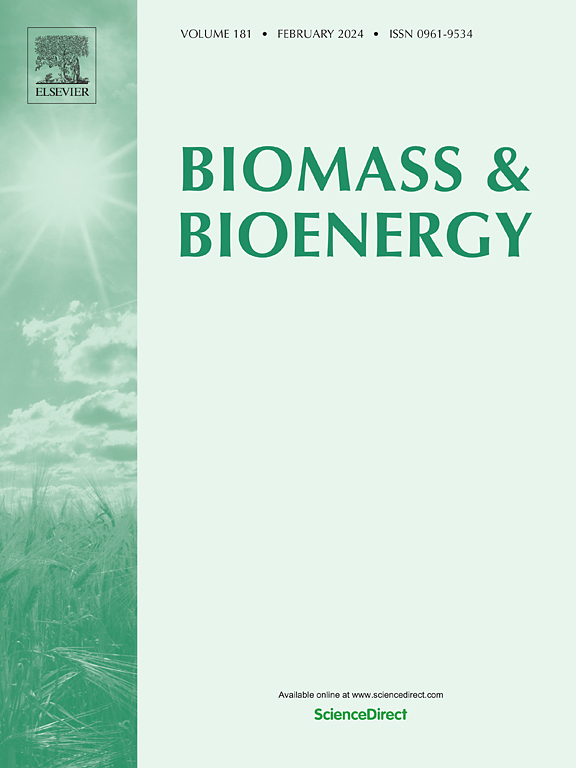Influence of nitrogen sources on growth and biochemical composition of Chlorella sorokiniana
IF 5.8
2区 生物学
Q1 AGRICULTURAL ENGINEERING
引用次数: 0
Abstract
The increasing demand for sustainable bioenergy solutions emphasizes the need of optimizing microalgae cultivation systems to achieve cost-effective and efficient biomass production. The potential of microalgae as a bioenergy feedstock is significantly influenced by nutrient optimization, particularly with respect to nitrogen. This study evaluated the effects of six nitrogen sources, each providing 25 mg N L−1: sodium nitrate (SN), potassium nitrate (PN), ammonium acetate (AA), ammonium nitrate (AN), ammonium sulphate (AS), and urea (U) on growth of Chlorella sorokiniana growth, carbon dioxide sequestration, biochemical composition, and theoretical methane potential (TBMP). The findings indicate that C. sorokiniana cultivated with AA produced the highest biomass at 1.62 ± 0.1 g L−1 and a protein content of 47.2 ± 1.8 %. Conversely, PN resulted in the highest lipid content (25.54 ± 1 %). SN demonstrated the most significant methane potential (421 ± 1.9 mL CH4 g−1 VS) and the highest CO2 fixation rate (0.18 g CO2 L−1 d−1), comparable to AA. These findings indicate that AA and SN present distinct advantages compared to other selected nitrogen sources. Specifically, AA enhances both biomass yield and nutrient content, while SN demonstrates superior capabilities in methane production potential and CO2 fixation. These results emphasize the necessity of judiciously selecting nitrogen sources to optimize the balance between bioenergy production, nutrient utilization, and economic viability in the microalgae cultivation.

氮源对小球藻生长及生化组成的影响
对可持续生物能源解决方案日益增长的需求强调了优化微藻培养系统以实现成本效益和高效生物质生产的必要性。微藻作为生物能源原料的潜力受到营养优化的显著影响,特别是氮。本研究评估了硝酸钠(SN)、硝酸钾(PN)、乙酸铵(AA)、硝酸铵(AN)、硫酸铵(AS)和尿素(U) 6种氮源(每个氮源提供25 mg N L−1)对sorokiniana小球藻生长、二氧化碳封存、生化组成和理论甲烷势(TBMP)的影响。结果表明,AA培养的sorokiniana生物量最高,为1.62±0.1 g L−1,蛋白质含量为47.2±1.8%。相反,PN组脂质含量最高(25.54±1%)。与AA相比,SN的甲烷潜力最大(421±1.9 mL CH4 g−1 VS), CO2固定率最高(0.18 g CO2 L−1 d−1)。这些结果表明,与其他氮源相比,AA和SN具有明显的优势。具体而言,AA提高了生物量产量和养分含量,而SN在甲烷生产潜力和二氧化碳固定方面表现出更强的能力。这些结果强调了合理选择氮源的必要性,以优化微藻养殖中生物能源生产、养分利用和经济可行性之间的平衡。
本文章由计算机程序翻译,如有差异,请以英文原文为准。
求助全文
约1分钟内获得全文
求助全文
来源期刊

Biomass & Bioenergy
工程技术-能源与燃料
CiteScore
11.50
自引率
3.30%
发文量
258
审稿时长
60 days
期刊介绍:
Biomass & Bioenergy is an international journal publishing original research papers and short communications, review articles and case studies on biological resources, chemical and biological processes, and biomass products for new renewable sources of energy and materials.
The scope of the journal extends to the environmental, management and economic aspects of biomass and bioenergy.
Key areas covered by the journal:
• Biomass: sources, energy crop production processes, genetic improvements, composition. Please note that research on these biomass subjects must be linked directly to bioenergy generation.
• Biological Residues: residues/rests from agricultural production, forestry and plantations (palm, sugar etc), processing industries, and municipal sources (MSW). Papers on the use of biomass residues through innovative processes/technological novelty and/or consideration of feedstock/system sustainability (or unsustainability) are welcomed. However waste treatment processes and pollution control or mitigation which are only tangentially related to bioenergy are not in the scope of the journal, as they are more suited to publications in the environmental arena. Papers that describe conventional waste streams (ie well described in existing literature) that do not empirically address ''new'' added value from the process are not suitable for submission to the journal.
• Bioenergy Processes: fermentations, thermochemical conversions, liquid and gaseous fuels, and petrochemical substitutes
• Bioenergy Utilization: direct combustion, gasification, electricity production, chemical processes, and by-product remediation
• Biomass and the Environment: carbon cycle, the net energy efficiency of bioenergy systems, assessment of sustainability, and biodiversity issues.
 求助内容:
求助内容: 应助结果提醒方式:
应助结果提醒方式:


